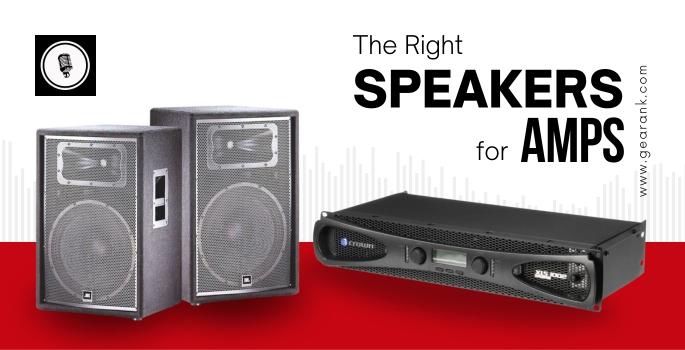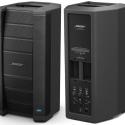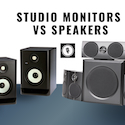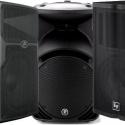Matching the Right Speakers for Amps - What to Look For

Matching Speakers for AmpsTo get the best possible sound quality and performance from your amp and speaker, ensure that they are matched in terms of power requirements, impedance, and sensitivity. |
In the age of speakers and amps, these two words are almost considered the same because they're frequently bundled with Bluetooth or PA speakers.
These two pieces of equipment, however, are separate. You might be reading this because you have speakers that require an external amp and vice-versa. After all, different types of speakers would require specific power ratings and specifications that are sometimes too daunting to understand.
Fortunately, you have Gearank on your side to help you. So, buckle up my fellow speakerheads, crank up the volume, and adjust your listening position. We're going on a journey to match the Right Speakers for Amps.
Here, we tell you everything you need to get started ranging from basic power matching to determining if the speaker or amp fits your specifications.
First order of things: What type of speakers use amps?
You'll often hear advice from sound system experts: never match a speaker with the wrong amplifier. What's the reason behind this? We need to clarify first what type of speakers even need amps in the first place.
You have types of speakers you have to keep in mind. You have active and passive speakers and they require different specifications. Active or powered speakers have built-in amplifiers in them. No need for external amplifiers for this one. Active speakers are built for easy plug and play. Passive or unpowered speakers are the exact opposite--they require a separate external amplifier to power them up.
As a reminder, active speakers do not require an external amplifier. External power sources are required for passive speakers only.
Active speakers provide the convenience of a hassle-free speaker setup, they have a stock speaker and a built-in amplifier all in one cabinet. What passive speakers lack in convenience, however, is the freedom to choose the amplifier you want to pair with. This way, it allows you to fine-tune the sound quality further.
Of course, the challenge comes in finding the right specifications.
Finding Speakers For Amps: What To Consider
There are some key things that you need to know when choosing the right speaker for your amp. You can't just hook up any of the two and expect them to be the perfect match. Matching speaker(s) each have their specifications that need to be followed. To ensure you have correct information, request the default specifications from the manufacturer, or the retail shop.
Finding the perfect match will involve three things that will make or break your system and they are:
-
Power
-
Impedance
-
Sensitivity
Keep in mind these three criteria. These are things that will apply regardless if it's for guitar amps, PA speakers, and even hi-fi systems.
1. Power
With the question of matching speaker(s), this is the first factor that anyone should consider. Power rating is the highest power input you can put through a single piece of equipment. It's also the amount of electrical power it takes to operate your device. When we refer to power (measured in watts), we are talking about the amp's ability to transfer power and the speakers' capacity to handle that amount of power.
We refer to them as continuous and dynamic, or peak power.
Power On Spec Sheets
On every specification sheet of your amp and speaker, you may notice different types of power mentioned. These power ratings are intertwined but there are a few things that they refer to.
The first is continuous power. The continuous power rating indicates how much power the equipment can put out over some time. It has less to do with volume but more on the amount of power an amplifier can output, even when it's not playing anything.
This means that, if you opt for a low-power amplifier with a higher-wattage speaker, you are going to run into trouble with your audio. The same goes for vice versa--putting too much power into your speakers could heat the components and damage them. All this, can damage your speakers, and a sure sign of this is buzz, noise, or bad sound quality.
Fortunately, modern speaker specification sheets will often give recommended amplifier requirements including an optimal power rating. Some are more detailed than others and may include minimum power recommendations and maximum peak power ratings.
For amplifiers, their specification sheets may give the power output for the ideal speaker based on resistance. Here's an example:
"50 w continuous power into 8 Ω (ohms)."
This means that the amplifier has a continuous power output of 50 watts into a speaker with 8 ohms of resistance. Check the spec sheet of your amplifier and compare it to the resistance of your speaker.
Dynamic Power
Dynamic or peak power refers to the maximum power output of an amplifier when it's pushed past its continuous power.
Using my earlier example, a peak power rating for an amplifier with 50w continuous power could be as high as 150W.
So, while the continuous power rating is the measure of wattage needed to run an amp, the peak power is the maximum wattage it can produce. However, most peak power outputs last milliseconds while continuous power is, well, continuous.
Power Mistakes To Avoid With Speakers and Amplifiers
There are often two ways in which speakers get damaged. First would be that, your amp has a continuous power rating that's too high for the speakers you have. It's like feeding a person with a big spoon with a small mouth. Too much continuous power from an amplifier results in speakers overheating. Akin to forcing someone’s mouth to open bigger.
The second scenario would involve an amplifier with a a lower continuous power rating but is connected to a speaker that requires a higher watts. There wouldn’t be any issues with an underpowered amp but the problem starts to happen once you crank up the volume knob. This forces the amp to produce more power. The amplifier begins to overcompensate.
Thus, when pairing the amp to the proper speakers, consider the amount of power the amp can produce, as well as the speakers’s capacity to handle continuous power.
2. Impedance
Impedance refers to what degree the electronic device can resist a fluctuating current. It's measured in ohms.
Specification sheets for both speakers and amplifiers will note the impedance of each device. However, there are typical ranges of impedance for both amps and speakers.
-
Most speakers are rated with an impedance between 4 and 8 ohms.
-
Amplifiers have a larger range of resistance. Many amps have an impedance between 4 and 16 ohms.
In general, it's safe to connect high-impedance speakers with an amp with lower impedance. However, connecting a low-impedance speaker to an amplifier with a much higher impedance requirement can damage your speakers.
3. Sensitivity
This factor is speaker-specific. Power and impedance addresses the capacity and resistance of electric currents. Sensitivity measures how loud a speaker will be when powered by one watt of power and set one meter away. How loud the speaker is is measured in decibels.
Here's an example: a speaker has a sensitivity rating of 100 dB (decibels). This means that with just 1 watt of power, the speaker produces a sound pressure level of 100 dB from 1 meter away.
Sensitivity also influences what kind of amplifier you will want to buy. With highly sensitive speakers, you don't need a larger amp to get the volume level you desire. This is important when buying your amplifier after you have bought your speaker.
One thing about speakers you also have to keep in mind is that the volume will drop off the further away you are from the source. Around 6 dB 'falls off' the volume of a speaker each time you double the distance between it and you.
Amplifiers need to double their power output to increase a speaker's sound level pressure just by 6 dB. So, you may need a powerful amp to get the sound levels as loud as you desire.
This is why sensitivity is an important factor to consider. You need to look at more than just the power and impedance of your speaker and amp to see if they are the right match. Otherwise, you could end up with a pair of speakers and an amplifier that doesn't meet your volume needs.
Power and impedance matching
Now that the terms have been demystified, if I go to Amazon or Sweetwater, what exactly should I be looking for? While different brands and manufacturers would have some slight differences in their speakers, all you have to remember is…
Match the nominal impedance. Then, the amplifier should be about around 1.5 to 2 times as powerful as the continuous power rating of your speaker.
In any spec sheet, the first info you need to know is the nominal impedance. Some speaker manufacturers use the nominal impedance to be descriptively accurate. However, it's worth clarifying that nominal impedance and impedance in spec sheets are the same.
So for instance, we have the Behringer Eurolive B215XL 1000W speakers. This PA speaker's nominal impedance is 8Ω and has 1000W Peak Power and 250W Continuous Power. We need here an amplifier that can supply twice its continuous power rating. That would be an amplifier capable of 500 W in 8Ω.
Yes, you can also select an amplifier that directly matches 250W as well. However, you also want the peaks in sound waves to have better headroom as well. Thus, to catch those peaks, an amp with a slightly higher continuous power rating is ideal. So here, we can use the Behringer NX3000D Power Amplifier. It has 440W of continuous power in 8Ω.
You should be aware of these different power ratings when dealing with speakers, regardless of brand, be it QSC, Electro Voice, JBL, etc.
On the Guitar Amp Speaker
In guitar speaker setups, you also have active and passive speakers. You have the combo amp like the popular Boss Katana 100 MkII, which is a full package combining a speaker with a built-in amplifier. On the other hand, you have guitar speakers and amps that are two separate components--an amp head and a cabinet.
In guitar amps, the speakers are usually replaced to achieve a certain tone. The tone you're looking for will, of course, depend from one speaker manufacturer to the other. Celestion, Eminence, and Electro-Voice would have different timbres for specific genres like blues, metal, and classic rock.
For guitar stacks, the specifications that you're looking for are the minimum impedance load and the total power handling. Typically, they have around 8Ω as the minimum requirement. Anything that goes below the minimum impedance will likely cause problems. As for the total power handling, you need a speaker that can handle twice what the amplifier head can put out.
Go and match any amp head, regardless of size; it will work fine. It doesn't matter if you have high-gain speakers or an amp with a full-bodied sound. As long as you match the minimum impedance and wattage specifications, you can mix and match speakers with no issues. Remember to do a speaker test, to ensure everything is matched accordingly and working properly.
Another factor to consider when pairing amps and speakers is weight. A big speaker with perfect sound won't be of much use if you can't carry it around.
If you want to know more specifically about amp heads, be sure to read up on "What is an amp head?"
Final Thoughts
Whether you're matching PA speakers, hi-fi systems, or guitar amps, you now have the basic building block of matching speakers for amps.
Choosing the right speakers for amps is entirely dependent only on 3 factors. You have power that is responsible for the energy input. Impedance for measuring how much the components can resist an electric charge. Finally, sensitivity is responsible for how accurately a speaker responds to the lower volumes and higher volumes.
You also have to keep in mind what type of speakers need an external amp - passive speakers that don't have a built-in power source.
Contributors:
- Alexander Briones - Editor
- Jerry Borillo - Illustrator












